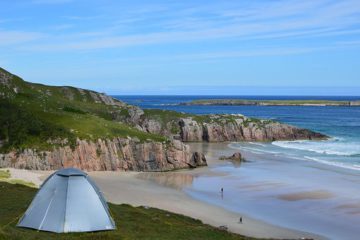Welcome Readers…
This article, ‘A Tent for Camping’ is yet another in a special Odyssey Posse Focus Collection relating to ‘CAMPING TENTS’. This particular series of posts is designed to give you a broader understanding of these awesome outdoor abodes
In this instalment we will be examining some of the important features and fittings that will separate a quality manufactured tent from a cheap, leaky, waste of your hard earned cash
A CLOSE INSPECTION…
“Sometimes it’s the little things that’ll make a big difference”
ROOF VENTS – If there are no ventilation ports in the top area of a 3 season tent (the most commonly purchased tent) and only a few windows around mid-height then they are basically useless in controlling condensation unless they’re always opened. A tent that has a vent or vents situated higher up in the tent are more effective at reducing moisture in the air. Remember, heat rises
HEAVY DUTY ZIPPERS – Check for robust, high quality, rust proof zippers that open and close easily and are clear from snagging easily on hems
POWER CORD ACCESS PORTS – Something to definitely consider if you will be using electrical appliances inside your tent. These handy little zippered holes are usually near the tent floor and allow you to run a power cords into your tent when camping at powered campsites or when using a generator
STORAGE POCKETS – We all need as much storage space as we can get when we’re camping and storage pockets and gear lofts are definitely something to look for in a camping tent. Storage pockets come in a variety of sizes and configurations depending on the type of tent and are usually sewn to the inner tent walls although some tent models have removable ones
GEAR LOFTS – These are an additional feature on some makes of tents and are also usually made from mesh. They are secured near the inner roof of the tent to provide over head storage
NO-SEE-UM MESH – This is a light weight, durable micro-mesh used for the screen doors, vents and windows of the tent. It is designed with an irregular, tight weave pattern that keeps out the tiniest of nasties (i.e. No-see-ums aka Sand flies aka Midges)
FABRICS AND COATINGS – See ‘What are tents made from?’ for a more in depth look at one of the most important things there is to know about tents…their construction
RIPSTOP – Keep an eye out for a mention of this when looking at what materials the tent is made of. It is a weaving technique whereby thicker reinforcement threads are sewn into the material to help prevent the fabric from ripping if it gets a hole in it. Although it’s not a feature in every quality tent fabric it is still a helpful indicator of a good quality tent
LIGHT/FAN HOOK – A very functional little hook strategically sewn to the inner roof of a tent for securing disc lights (no, not disco lights) in low roof tents and lights or light/Fan combos which are more often used in high roof tents to provide a bit of extra light and ventilation
DOOR/WINDOW CONFIGURATION – Be conscious of the amount of doors and windows and their positioning in relation to maximising airflow (ventilation). There’s nothing worse than an unbearably hot tent summertime without the ability to open it up and get some air circulating through
FOLDED SEAMS & DOUBLE STITCHING – Another thing to look for as this is an indication of a quality tent that will ensure strength and water resistance. Folded, double stitched seams such as the ‘full flat felled seam’ are a 100% as strong as the fabric itself and almost 100% waterproof without a waterproof coating or being ‘seasoned’
TAPE SEALED SEAMS – Something to be aware of in tents made of anything other than canvas is tape sealed seams. The waterproof tape ensure that the tent won’t leak where it has been stitched. Inspect the inside of the tent when initially pitched to make sure all seams are taped properly
TUB/BUCKET FLOOR – Tub floors (otherwise known as bucket floors) are a hard wearing ground cover material usually made from a heavy gauge PU-coated nylon taffeta or polyethylene that is stitched into the bottom of the tent (usually, approx. 6 inches up the sides) in order to keep out water, mud, dirt and creepy crawlies. Once again, check that these are sewn in using double stitching and folded seams
VESTIBULES – Like a miniature awning, these are extensions of the outer fly of the tent which provide added shelter and room for storing extras that you prefer to keep outside the tent (dirty hiking boots, climbing gear, wet clothes and towels, etc.)
AWNINGS – Much larger than vestibules but do the same thing. Some family tents have multiple awnings which are great for extra “living space” and shade in hot weather and keeping you and your stuff dry in wet weather
PEGS – 99.9% of tents sold come with pegs supplied but more often than not they are only cheap ones that are ‘good enough’ to do the job if you are pitching your tent on grassy, semi-hard ground but there are multitude of pegs available for different ground conditions (Sand, rock-hard ground, snow, etc.) so I suggest you do your homework as to what pegs are available for the type of surface you’ll be camping on so you can get some before heading off
POLES – A lot of camping tents come with fibreglass poles and although they do a good job at standing up to most conditions you’ll encounter, they’re not indestructible. That doesn’t mean that a tent with fibreglass poles is cheap but there are alternatives and if your serious about a more robust tent frame then you should you should opt for a tent with aluminium poles or have some custom made
WARRANTY – When researching tents, look for what the manufacturer warranty covers and preferably look for “Lifetime Warranties” as this shows that the manufacturer wholeheartedly stands by their product
Whether it be a 2 person or a 20 person tent you’re looking at, after reading this series you will be able to identify the pros and cons of every tent on the market
HAPPY ADVENTURES!




0 Comments